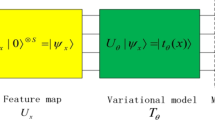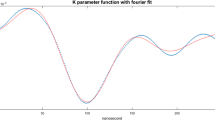Abstract
Neural networks have attracted much interest in the last two decades for their potential to realistically describe brain functions, but so far they have failed to provide models that can be simulated in a reasonable time on computers; rather they have been limited to toy models. Quantum computing is a possible candidate for improving the computational efficiency of neural networks. In this framework of quantum computing, the Qubit neuron model, proposed by Matsui and Nishimura, has shown a high efficiency in solving problems such as data compression. Simulations have shown that the Qubit model solves learning problems with significantly improved efficiency as compared to the classical model. In this paper, we confirm our previous results in further detail and investigate what contributes to the efficiency of our model through 4-bit and 6-bit parity check problems, which are known as basic benchmark tests. Our simulations suggest that the improved performance is due to the use of superposition of neural states and the use of probability interpretation in the observation of the output states of the model.
















Similar content being viewed by others
References
Deutsch D, Jozsa R (1992) Rapid solution of problems by quantum computation. Proc R Soc Lond Ser A 439: 553–558
Shor PW (1994) Algorithm for quantum computation : discrete logarithms and factoring. In: Proceedings of the 35th annual IEEE symposium on foundations of computer science, pp 124–134
Arbib MA (2002) The handbook of brain theory and neural networks. MIT press, Cambridge
Kak SC (1995) On quantum neural computing. Information Sciences 83:143–163
Peruš M (1996) Neuro-quantum parallelism in brain-mind and Computers. Informatica 20:173–183
Behrman EC, Niemel J, Steck JE, Skinner SR (1996) A quantum dot neural network. In: Proceedings of the workshop on physics of computation, pp 22–24
Menneer TSI, Narayanan A (1995) Quantum-inspired neural networks. Technical report University of Exeter Research Report R 329
Ventura D, Martinez T (1997) An artificial neuron with quantum mechanical properties. In: Proceedings of the international conference on neural networks and genetic algorithms, pp 482–485
Matsui N, Takai M, Nishimura H (1998) A network model based on qubit-like neuron corresponding to quantum circuit (in Japanese). IEICE J81-A 12:1687–1692. (2000) Electronics and Communications in Japan 3 83 10:67–73
Kouda N, Matsui N, Nishimura H (2002) A multi-layered feed-forward network based on Qubit neuron model (in Japanese). IEICE J85-DII 12:641–648. (2004) Systems and Computer in Japan 35 13:43–51
Matsui N, Kouda N, Nishimura H (2000) Neural network based on QBP and its performance. In: Proceedings of international joint coference on neural networks ’2000 III:247–252
Kouda N, Matsui N, Nishimura H (2000) Learning performance of neuron model based on quantum superposition. In: Proceedings of the 2000 IEEE international workshop on robot and human interactive communication, pp 112–117
Kouda N, Matsui N, Nishimura H (2002) Image compression by layered quantum neural networks. Neural Processing Lett 16(1):67–80
Kouda N, Matsui N, Nishimura H (2002) Control for swing-up of an inverted pendulum using Qubit neural network. In: Proceedings of SICE annual conference 2002 in Osaka, pp 805–810
DiVincenzo DP (1995) Quantum Computation. Science 270:255–261
Barenco A, Bennet CH, Cleve R, DiVicenzo DP, Margolus N, Shor P, Sleator T, Smolin J, Weinfurter H (1995) Elementary gates for quantum computation. Phys Rev A 52:3457–3467
Nitta T (1997) An extension of the back-propagation algorithm to complex numbers. Neural Netw 10(8):1391–1415
Acknowledgements
This study is financially supported by Grant-in-Aid for Scientific Research (C-13680458), Japan Society for the Promotion of Science.
Author information
Authors and Affiliations
Corresponding author
Rights and permissions
About this article
Cite this article
Kouda, N., Matsui, N., Nishimura, H. et al. Qubit neural network and its learning efficiency. Neural Comput & Applic 14, 114–121 (2005). https://doi.org/10.1007/s00521-004-0446-8
Received:
Accepted:
Published:
Issue Date:
DOI: https://doi.org/10.1007/s00521-004-0446-8




